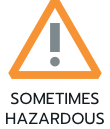Fertilizer
Disposal guidance for eligible businesses

 Accepted at hazardous waste collection sites - eligible businesses only
Accepted at hazardous waste collection sites - eligible businesses only
Disposal requirements vary:
Fertilizers with pesticides or herbicides, often called weed and feed, are accepted at hazardous waste collection sites (eligible businesses only).
- All containers must be 5 gallons or less
- Total waste limit is 25 gallons or 220 pounds per trip
- Professional grade fertilizers are not accepted
- Businesses must bring a completed disposal form to the disposal location
- Businesses are allowed a maximum of four visits per year
Solid fertilizers with no pesticides can go in the garbage. Liquid fertilizers with no pesticides can be solidified using dirt, kitty litter, paper towels, or other absorbent materials and put in the garbage.
Dry and empty containers, including aerosol cans, can go in the garbage (no need to rinse). Do not recycle fertilizer containers.
Frequently-Asked Questions
Your business is eligible to receive no-fee hazardous waste disposal up to four times a year if it is:
- Located in King County
- A Small Quantity Generator (SQG), meaning that you do all of the following:
- Produce less than 220 pounds (about 25 gallons) of hazardous waste per month
- Produce less than 2.2 pounds (about a quart) of acutely hazardous waste per month
- Store less than 2,200 pounds (about four 55-gallon drums) of hazardous waste
If your business exceeds the noted limits, you may require special disposal services via a private hazardous waste management firm. We can help! Call us at 206-296-4692.
Eligible businesses should plan to fill out a business disposal form to qualify for no-fee disposal at any hazardous waste collection site.
- Complete the form. You can find a digital copy online, or download the PDF [insert link]. Print two copies and bring them with you to your preferred collection site.
- Prep for disposal. Keep items in their original containers and label those products that are unmarked. Be careful not to mix different types of waste and secure items so they do not spill or tip over during transport.
- Drop off your hazardous items. Bring your items to a disposal collection site. There’s no fee—the service is funded through your utility bill.

 Translate
Translate